The Early Years
Before Nomadic
Nomadic’s story started with the SS Gallic which was a 461 gross registered tonnage paddle steamer, built in 1894. She was purchased from the Birkenhead Corporation in 1907 by the White Star Line to serve as a passenger tender out of Cherbourg. This was necessitated by the fact that, despite being a popular port for steamers outbound on the Atlantic trade route, Cherbourg was too small at that time to accommodate the massive ocean liners of the day.

In 1907 White Star decided to embark on an ambitious plan to build the largest and most luxurious liners the world had ever seen, the Olympic class. This was in retaliation to the success of their main rival, Cunard, who had garnered much favourable publicity as a result of their blue riband winning liners RMS Mauretania and RMS Lusitania. Although not as fast as the Cunard vessels, the Olympic class would represent the very pinnacle of the golden age of sea going opulence and style. In these heady times SS Gallic must have seemed somewhat antiquated and was too small to serve the ever larger White Star vessels which waited offshore at Cherbourg for burgeoning crowds of passengers.
Purpose Built Tender
As a result of this, White Star commissioned the building of two all new tenders, the SS Traffic, for 3rd class steerage passengers, and the SS Nomadic, for 1st and 2nd class. Nomadic, in line with her elevated status over her sibling, was larger and graced with a high degree of luxury fittings, in many ways similar to that of her big sisters, the Olympic class mail steamers, who she was designed to serve.
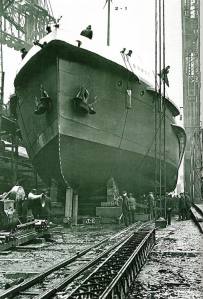
Nomadic’s keel was laid 3 days before Christmas on 22nd December 1910, while all around her the gigantic profiles of Olympic and Titanic rose high into the air. At 233.6 ft in length and a gross registered tonnage of 1273 tonnes she could carry upwards of 1000 passengers and make a speed of 12 knots. Nomadic was launched from slip No.1, Queens Island at Harland and Wolff shipyards, Belfast on 25th April 1911. She completed her sea trials on 16th May 1911 and was handed over to the White Star line on 27th May of that year. On 31st May 1911, Titanicwas launched and on that same day Olympic was handed over to White Star. VIP’s such as Lord Pirrie and Bruce Ismay were ferried to Olympic aboard Nomadic and the two vessels sailed down Belfast Lough together to begin their careers, Olympic making a stopover in her port of registry, Liverpool, before commencing to Southampton, and Nomadic sailed on to her duties as a tender out of Cherbourg, France.
Nomadic and Traffic both arrived in Cherbourg on 3rd June 1911 (Nomadic commanded by Captain Boitard), they were reunited with Olympic on 14th September 1911 when she called for passengers at Cherbourg on the outset of her maiden voyage to New York. On 13th November she was damaged as a result of a collision with the American Lines vessel Philadelphia. On the 10th April 1912 Nomadic sailed out from port with 142 first class passengers to meet RMS Titanic on her maiden… and only, fateful journey into history and legend. Onboard her that evening were many of the most famous participants in the great calamity which was soon to unfold. Among her compliment were Sir Cosmo and Lady Duff Gordon, the 8th Baronet Duff of Halkin, Benjamin Guggenheim, who upon realizing his fate stated, “we’ve dressed up in our best and are prepared to go down like gentlemen”. Also onboard was the unforgettable and “unsinkable” Molly Brown. Nomadic was to go on serving the Olympic throughout her successful career while SS Gallic was scrapped in 1913.
The World Wars
The Great War
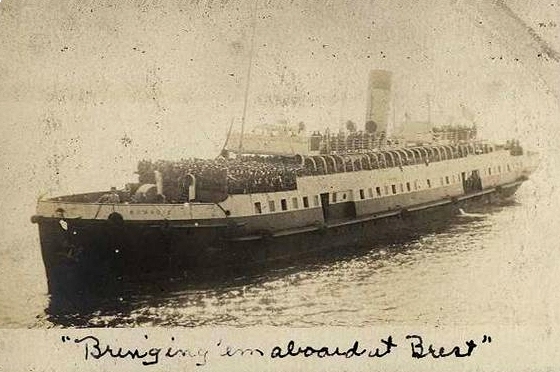
On 25th April 1917, Nomadic was requisitioned by the French Government and sent to Brest. From 12th November she served there as a troop ship for the U.S. 7th Infantry division, a post she would hold for almost two years. After World War 1 Nomadic returned to commercial service, tending to the Cunard Liner Caronia on the first post war Transatlantic calling in Cherbourg on 2nd September 1919. Nomadic continued to tend her glamorous relatives throughout this period but met with misfortune once more in 1928 when she was involved in another collision with the Liner Orinocco.
Changes were taking place in the North Atlantic shipping trade, immigration was falling (the main source of profits for the large Liners at this time, which accommodated large numbers of steerage passengers) and White Star Lines were to be a casualty when they were forced to merge with their old nemesis Cunard in 1934, creating Cunard-White Star Limited. Nomadic & Traffic were sold to the Societe Cherbourgeoise de Sauvetage et de Remorquage (SCSR) and Nomadic was renamed Ingenieur Minard (the engineer who created the modern harbour of Cherbourg). Her funnel was painted in black & red, her mast was moved and some cuttings were made in order to ease the moving of the gangways. From this time, the modern harbour of Cherbourg became operational. Liners could then be moored in the harbour and tenders were used only for ‘short callings’ or in the case of bad weather… Nomadic was out of a job!
World War II
On 18th June 1940 the German army invaded Cherbourg. Nomadic evacuated British soldiers and workers of the Amiot Manufacture (aircraft manufacture) to two cargo ships which then set sail to Brest. Nomadic then made her way to Portsmouth, England where she was requisitioned once more, this time by the British Government. She was to spend the next five years as a troop ship, ferrying apprentice soldiers from Portsmouth to the Isle of Wight. At the end of World War II Nomadic returned to France, she was now over 35 years old and in line to be scrapped… but it was not to be, she was saved by the manager of the SCSR on 27th June 1945 and returned to her now familiar working port of Cherbourg on 8th July of that year, undergoing one month of very needed repairs.
Her Latter Years
An Auspicious End
An ironic twist of fate was Nomadic’s saviour. The Germans had destroyed the new Port of Cherbourg making tender ships once again essential to the Transatlantic shipping route. This was the beginning of a proud era for Nomadic, for the next 23 years she would go on to serve many of the worlds great Liners including the Cunard owned RMS Queen Maryand the RMS Queen Elizabeth. Cunard stating that Nomadic was he best Queens tender. She finally ended her active service when she rendezvoused with the Queen Elizabeth for the last time on 4th November 1968.
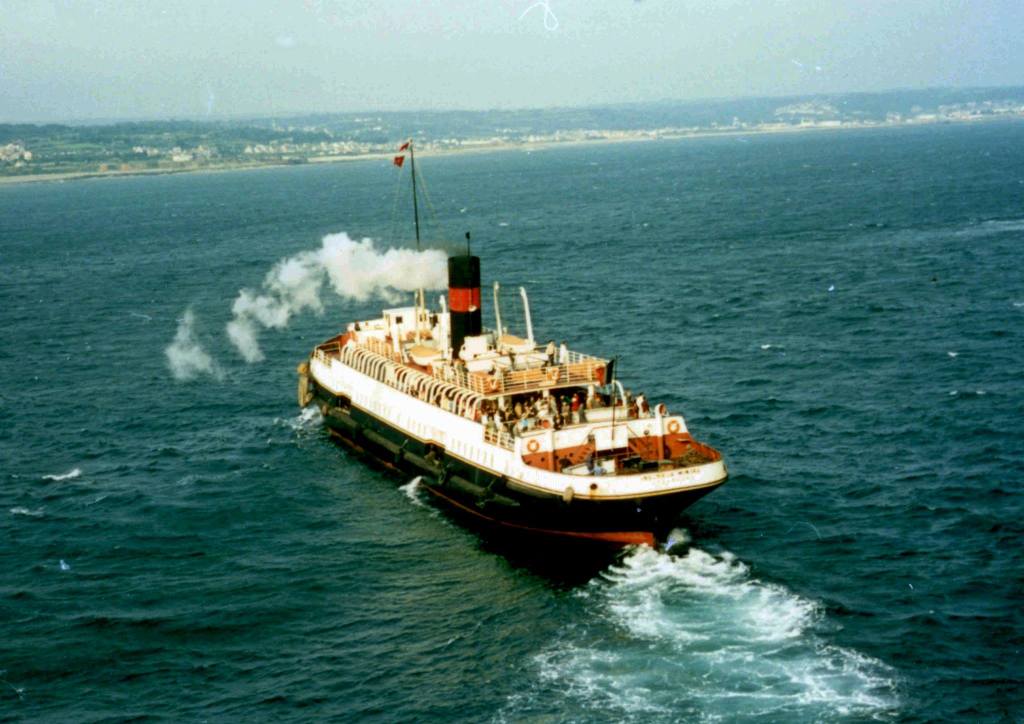
With her proud and productive service career now behind her and almost sixty years old, Nomadic was once again put on the market for scrapping… And once again a French man was to be her rescuer. She was purchased by Mr. Spinnewyn, a French businessman who had ideas of transforming her into a massive floating restaurant. On 26th April 1969 Nomadicwas towed from Cherbourg to Le Havre, and later, up the River Seine to Conflan-Sainte-Honorine. Nomadic was too tall to clear the many bridges on the River Seine and extensive modifications were made to her for transport to her intended mooring in Paris. Her funnel was removed, as was her flying bridge deckhouses and her faithful twin, two cylinder, compound steam engines were removed. It was also at this time that many of her grand fittings went missing including many copper, brass and bronze items as well as porcelain water fountains, the ships bell and countless other iconic White Star Line artefacts which were unrecorded and may never be seen again.
A Floating Restaurant
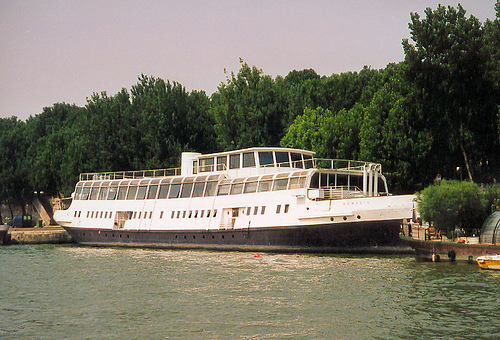
Mr. Spinnewyn was not to realize his ambitions for Nomadic. He ran out of money and she was again sold to another entrepreneur named Yvon Vincent. It was Vincent who was to make a success out of the proud little White Star tender on the Seine. Nomadic arrived in Paris on the 17th October 1974 when her transformation into a floating restaurant and function venue was begun, including a 100 seat cinema/auditorium where the engine room once existed. Hard to believe, but in order for her to make the journey under the low bridges of Paris, she had to be flooded with about 800 tonnes of water. A somewhat risky maneouvre you might say! She opened to the public in Paris, opposite the historic Eiffel Tower on 26th June 1977 and was to host innumerable weddings, ceremonies, conventions and concerts for the next 22 years – and various states of modification. Nothing however lasts forever and new European regulations were introduced insisting that all vessels moored on the Seine had to undergo periodical examinations in dry dock to verify their hull integrity. This was impossible for Nomadic whose superstructure had been rebuilt and once again could not pass under the low bridges. The hull was inspected by divers but the Paris harbour officials demanded a dry dock visit and Nomadic’s license was cancelled as a result. Unable to operate his vessel any longer, Yvon Vincent quickly slipped into debt and administrative difficulties… Nomadic was out of a job once again.

The Paris Harbour authorities seized Nomadic in 2002, they decided to move her to Le Havre for inspection and in September work began once more to cut away her superstructure in order to bypass the bridges. Stripped to deck level and looking rather battered and tired, she was towed out of Paris on the 1st April 2003, arriving in Le Havre three days later to await her fate. Mr. Vincent was now in deep financial trouble and was prepared to sell Nomadic… for £2,500,000. With no offers and no money left it seemed as though Nomadic had used up all of her nine lives and was finally out of luck. But, as a result of pressure from the voluntary group “Belfast Industrial Heritage” and many worried enthusiasts along with recommendations by the “French Titanic Society”, The French Ministry of Culture agreed to temporarily list the ship on the French Historical Monument Register for one year. SaveNomadic.com was set up to try and highlight Nomadic’s plight and raise funds to try and save the vessel.
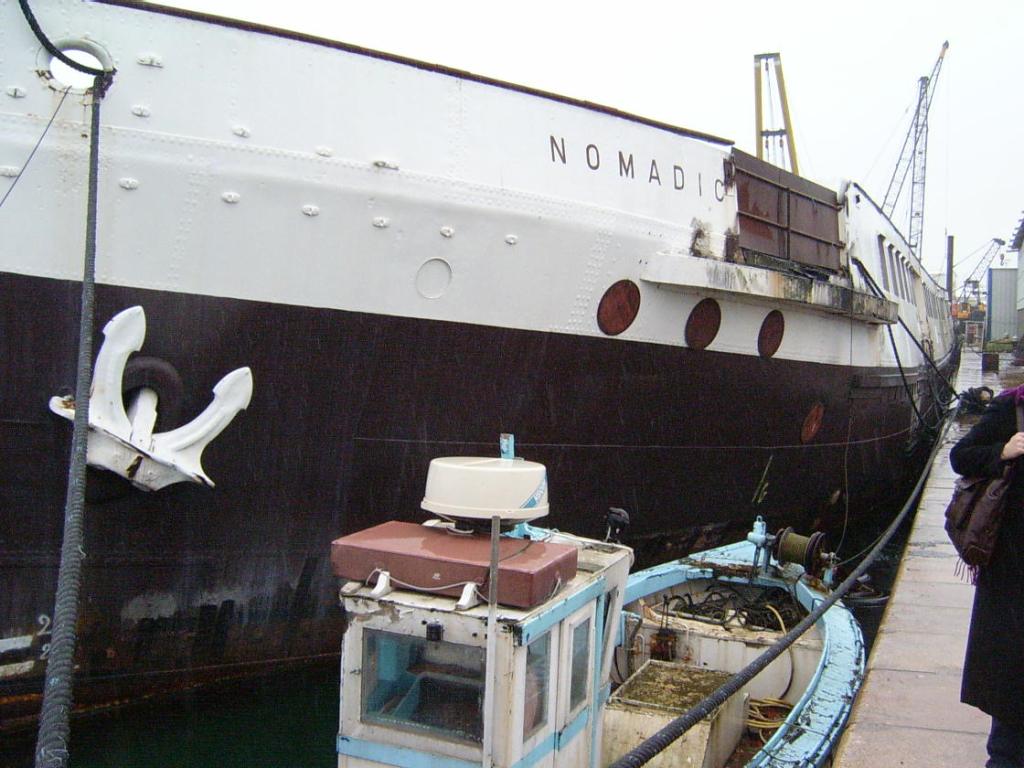
Yvon Vincent died in March 2005 and Paris Harbour’s Legal Department requested the ship be auctioned off by the Crown Court of Paris for scrap. The first auction took place on 10th November 2005 and the reserve price was set at €500,000 but there were no bids. Another auction was scheduled on 26th January 2006 with the reserve lowered to €250,000. On the 26th January the auction was held, only one bid was placed… by the Government Department for Social Development for €250,001 (£171,320) and Nomadic was saved from the scrap yard for the third time. The appeal had been an outstanding success, Nomadic’s luck had held out yet again and Titanic’s ‘little sister’ was going home at long last after almost a century.
Homecoming
Nomadic remained in Le Havre for several months while inspections were made and preliminary work was carried out prior to her transportation back to Belfast. It was found that despite being over 95 years old, her hull was still in remarkably good condition. It was also decided that it would be safer to bring her home upon a submersible barge. The tender to transport her was won by Anchor Marine and Hammer Marine Services, international companies who specialise in this sphere of marine work and operate a fleet of submersible transportation barges. On 12th July 2006 she was loaded onto the 91.46 metre long AMT Mariner at Le Havre and 3 days later she was finally docked at the outfitting wharf of her original builders, Harland and Wolff shipyards, Belfast in Northern Ireland. Nomadic was back home for the first time since her farewell to the men who built her in 1910/1911, back in her birthplace after an absence of 95 years, 1 month and 19 days.
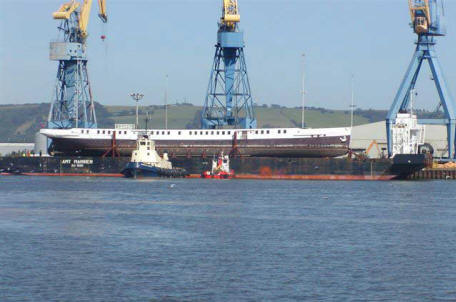
SS Nomadic had her official reception at the Queens Quay on 18th July 2006. Her triumphant return was heralded by a speech by the minister of Social Development and well wishes from the thousands of people who had come to see her in the blazing summer sun. The last of her line and ambassador for a golden age of steam now long gone.
For more on Nomadic’s Design and Specifications see here

You must be logged in to post a comment.